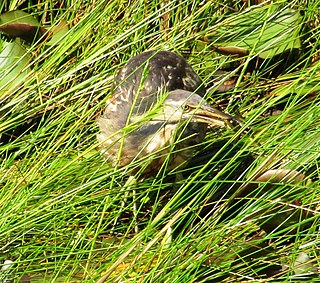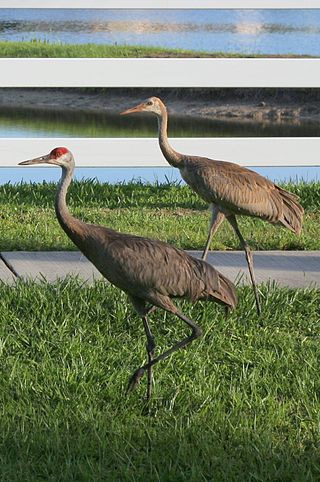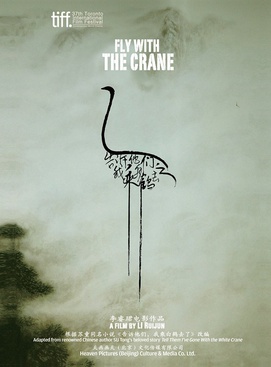Crane or cranes may refer to:

Cranes are a type of large bird with long legs and necks in the biological family Gruidae of the order Gruiformes. The family has 15 species placed in four genera which are Antigone, Balearica, Leucogeranus, and Grus. They are large birds with long necks and legs, a tapering form, and long secondary feathers on the wing that project over the tail. Most species have muted gray or white plumages, marked with black, and red bare patches on the face, but the crowned cranes of the genus Balearica have vibrantly-coloured wings and golden "crowns" of feathers. Cranes fly with their necks extended outwards instead of bent into an S-shape and their long legs outstretched.

The common crane, also known as the Eurasian crane, is a bird of the family Gruidae, the cranes. A medium-sized species, it is the only crane commonly found in Europe besides the demoiselle crane and the Siberian crane that only are regular in the far eastern part of the continent. Along with the sandhill crane, demoiselle crane and the brolga, it is one of only four crane species not currently classified as threatened with extinction or conservation dependent on the species level. Despite the species' large numbers, local extinctions and extirpations have taken place in part of its range, and an ongoing reintroduction project is underway in the United Kingdom.

Bitterns are birds belonging to the subfamily Botaurinae of the heron family Ardeidae. Bitterns tend to be shorter-necked and more secretive than other members of the family. They were called hæferblæte and various iterations of raredumla in Old English; the word "bittern" came to English from Old French butor, itself from Gallo-Roman butitaurus, a compound of Latin būtiō (buzzard) and taurus (bull).

A crane fly is any member of the dipteran superfamily Tipuloidea, which contains the living families Cylindrotomidae, Limoniidae, Pediciidae and Tipulidae, as well as several extinct families. "Winter crane flies", members of the family Trichoceridae, are sufficiently different from the typical crane flies of Tipuloidea to be excluded from the superfamily Tipuloidea, and are placed as their sister group within Tipulomorpha.

The Deschutes River in central Oregon is a major tributary of the Columbia River. The river provides much of the drainage on the eastern side of the Cascade Range in Oregon, gathering many of the tributaries that descend from the drier, eastern flank of the mountains. The Deschutes provided an important route to and from the Columbia for Native Americans for thousands of years, and then in the 19th century for pioneers on the Oregon Trail. The river flows mostly through rugged and arid country, and its valley provides a cultural heart for central Oregon. Today the river supplies water for irrigation and is popular in the summer for whitewater rafting and fishing.

The sandhill crane is a species of large crane of North America and extreme northeastern Siberia. The common name of this bird refers to their habitat such as the Platte River, on the edge of Nebraska's Sandhills on the American Great Plains. Sandhill cranes are known to frequent the edges of bodies of water. The central Platte River valley in Nebraska is the most important stopover area for the nominotypical subspecies, the great sandhill crane, with up to 450,000 of these birds migrating through annually.

The red-crowned crane', also called the Manchurian crane '(traditional Chinese: 丹頂鶴; simplified Chinese: 丹顶鹤; pinyin: dāndǐng hè; Japanese: 丹頂鶴 or タンチョウヅル; rōmaji: tanchōzuru; Korean: 두루미; romaja: durumi; the Chinese character '丹' means 'red', '頂/顶' means 'crown' and '鶴/鹤' means 'crane'), is a large East Asian crane among the rarest cranes in the world. In some parts of its range, it is known as a symbol of luck, longevity, and fidelity.

Zhi Dun was a Chinese Buddhist monk and philosopher. A Chinese author, scholar and confidant of Chinese government officials in 350, he claimed that all who followed Buddhism would, at the end of their life, enter Nirvana.

The black-necked crane is a medium-sized crane in Asia that breeds on the Tibetan Plateau and remote parts of India and Bhutan. It is 139 cm (55 in) long with a 235 cm (7.71 ft) wingspan, and it weighs 5.5 kg (12 lb). It is whitish-gray, with a black head, red crown patch, black upper neck and legs, and white patch to the rear of the eye. It has black primaries and secondaries. Both sexes are similar. Some populations are known to make seasonal movements. It is revered in Buddhist traditions and culturally protected across much of its range. A festival in Bhutan celebrates the bird while the Indian union territory of Ladakh has designated it as the state bird.

The Nematocera are a suborder of elongated flies with thin, segmented antennae and mostly aquatic larvae. This group is paraphyletic and contains all flies but species from suborder Brachycera, which includes more commonly known species such as the housefly or the common fruit fly. The equivalent clade to Nematocera is the whole Diptera, with Brachycera as a subclade. Families in Nematocera include mosquitoes, crane flies, gnats, black flies, and multiple families commonly known as midges. The Nematocera typically have fairly long, fine, finely-jointed antennae. In many species, such as most mosquitoes, the female antennae are more or less threadlike, but the males have spectacularly plumose antennae.
Crazylegs Crane is a 16-episode made-for-television cartoon series produced by DePatie–Freleng Enterprises in 1978 for The All New Pink Panther Show on ABC.

Limoniidae is the largest of four crane fly families, with more than 10,700 species in more than 150 genera. Some studies have suggested it to be a paraphyletic group, with some limoniids being more closely related to Tipulidae and Cylindrotomidae than to other limoniids. Limoniid crane flies can usually be distinguished by the way the wings are held at rest. Limoniids usually hold/fold the wings along the back of the body, whereas other crane flies usually hold them out at right angles. Snow flies such as Chionea scita have no wings at all. Limoniids are also usually smaller than other crane flies, with some exceptions.

Crane Beach is a 1,234-acre (4.99 km2) conservation and recreation property located in Ipswich, Massachusetts, immediately north of Cape Ann. It consists of a four-mile-long (6 km) sandy beachfront, dunes, and a maritime pitch pine forest. Five and a half miles of hiking trails through the dunes and forest are accessible from the beachfront.

Tipula is a very large insect genus in the fly family Tipulidae. The members of this genus are sometimes collectively called common crane flies. Tipula contains over 2,000 species located throughout the world.

Operation Migration was a nonprofit, charitable organization, which developed a method using ultralight aircraft to teach migration to captive-raised, precocial bird species such as Canada geese, trumpeter swans, sandhill cranes, and endangered whooping cranes.

Hutoushan Reservoir is a man made reservoir in Lhünzhub County, Tibet, to the north of the city of Lhasa. It is an important wintering place for black-necked cranes and other migratory birds.

A catcher pouch is a mail bag that can be used in conjunction with a mail hook to "catch" mail awaiting pickup from a moving train. Catcher pouches were most often used by railway post offices in the nineteenth century and the early twentieth century. Its use was limited to exchanges onto moving trains. The specially constructed catcher pouch was grabbed by the catcher mechanism in the passing railway car and the catcher pouch would release from the holding rings on the mail crane. This technique was known as "mail on the fly". Starting in the 1870s the use of this technique of the Railway Mail Service was an important issue in the United States. It was a popular technique and the backbone of the United States Postal Service through the 1930s.
Fly Blue Crane was a South African regional airline based in Johannesburg, with its hub at O. R. Tambo International Airport, Johannesburg, South Africa. The company slogan is A fresh approach.

Fly with the Crane is a 2012 Chinese film written and directed by Li Ruijun and adapted from the novel Tell Them I've Gone with the White Crane, by Su Tong. It made its premiere at the 69th Venice International Film Festival, in 2012.
















